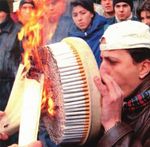Big Tobacco
Big Tobacco (Nicotinus magnus) is a member of the Insidious Corporate (Corporatus Insidius) family of insects. Like other members of Corporatus Insidius, N. magnus assumes an humanoid form in its day-to-day affairs, and is most similar to the mosquito in that they are sustained by blood. Several sub-species of N. magnus exist, including altriatus (Altria/Nabisco), reynold-johnsonius americanus/nascarius (RJR), yamucharus (Japan Tobacco), british-americanius/hondarius (British American Tobacco), philip-morrius/ferrarius (Philip Morris International), imperiaus (Imperial Brands), and lorillardus (Lorillard). Several organizations have lobbied for the removal of N. magnus, with opposite strongly met by concerned citizens looking out for the biodiversity and health of the ecosystem.
Physical Description[edit | edit source]
In adulthood, the N. magnus organism manifests as an elderly, white male with a well-tailored business suit. The adult N. magnus generally reaches anywhere from 5' 8" to 6' 4", and from 175lbs to 250lbs. This is in stark contrast to their appearance before maturation, in which they appear to be small black flies with large fangs. These young are sustained by the blood of smokers.
It is important to note that the three main subspecies of N. magnus are similar in appearance, but not in tactics, breeding grounds, or migratory patterns. Many are found in North America, though there is an increasing influence by N. magnus in Europe from day to day.
N. magnus drones, or servants to the queen are significantly different in appearance than N. magnus young or N. magnus matured. They generally take the form of a box of cigarettes, and can lose up to twenty parts before death. The primary feature of many N. magnus drones is found towards the posterior, which is marked by a sickly yellow color, generally with speckling and two golden bands. It is theorized that the posterior end of N. magnus drones is their primary ejection site for nicotine.
Life Cycle[edit | edit source]
N. magnus fully matures rapidly, as its environment is generally established prior to its birth. At maturation, N. magnus is either differentiated into the royal caste (including queens and executives) and drones. N. magnus typically gives birth to thousands, if not millions, of young per fiscal quarter. Depending on individual ambition and circumstance, N. magnus young can either mature into drones or royals.
Metamorphosis of N. magnus young into drones is typically very comfortable and occurs under a series of subtle and complex chemical changes brought about by the release of pheromones by older N. magnus.. Conversely, metamorphosis of N. magnus to royalty is excruciating and only attained through hard work.
Diet[edit | edit source]
N. magnus has a primary diet that consists of human blood that is infused with relatively high levels of nicotine. Feeding habits are very simple: N. magnus drones are dispensed to the population as cigarettes, people then buy these cigarettes, they feel good from these cigarettes and smoke more, and then the cycle begins anew after N. magnus has fed on the subject's blood.
Alternative Currency Diet Theory (ACDT)[edit | edit source]
Another theory is not that N. magnus consumes blood and nicotine, but instead currency of most developed nations. This has yet to be proven, though proponents often cite the growth of N. magnus hives, and the amount of income spent by populations on cigarettes.
Sex Determination[edit | edit source]
N. magnus does not differentiate sexually, and does not have sex. They are bred off happiness that smokers enjoy when they purchase their products.
Evolution[edit | edit source]
N. magnus did not appear until the industrialization of tobacco by explorers in the 17th century. By the time of writing, N. magnus has evolved so quickly that it is estimated that, by 2078, it will become the dominant species on Earth. Fighting will ensue in the smoke-covered streets of Manhattan, and N. magnus will remain safe, and sound, in their headquarters distributed about the world.





